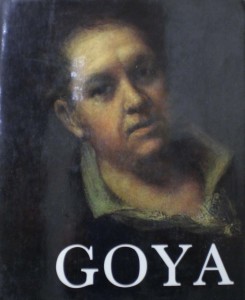
In his post, Eric argued that Moore’s Swamp Thing is feminist, both because it presents Abby as a strong, heroic figure and because it critiques Swamp Thing’s own abusive use of patriarchal power.
I agree with Eric that power and gender are both important themes in the Swamp Thing series. I’m less certain that Moore always manages to be especially thoughtful about them, though. It seems to me, on the contrary, that in the marriage between Moore and his tropes, it’s as often the green, lumpy pulp that wears the jeans in the relationship as it is the feminism.
Having brutally murdered that innocent metaphor…I thought I’d look back at the same issues I discussed in my first post — the two-part story in which Swamp Thing goes to Rann.
This story is built around doubled couples: Swamp Thing, in exile from earth and Abby, is mirrored by Adam Strange, who is in a constant vacillating exile from Rann and his wife, Alanna. In both of these pairings, the male/female roles are apportioned in familiar manner. Swamp Thing and Adam are the seekers, questing across space, engaging in feats of daring-do, in order to return to hearth and home embodied by Abby/Alanna. Female means stability and civilization; male means adventure and rough virility. Moore is careful to tell us that the people of Rann are hairless, and that they see Adam as a kind of atavistic hairy monster. Alanna, then, is a (literally) smooth, perfect, (literal) princess in a tower; a fairy tale dream — just as Abby is referred to as a “Hans Anderson princess” at the very end of Moore’s run on the series.
Moore, moreover, links his males questing nobly for the womb explicitly to phalluses and sperm. There’s one sequence where Swamp Thing gets transformed into a bulbous member spouting suggestive liquid…and look at that caption.
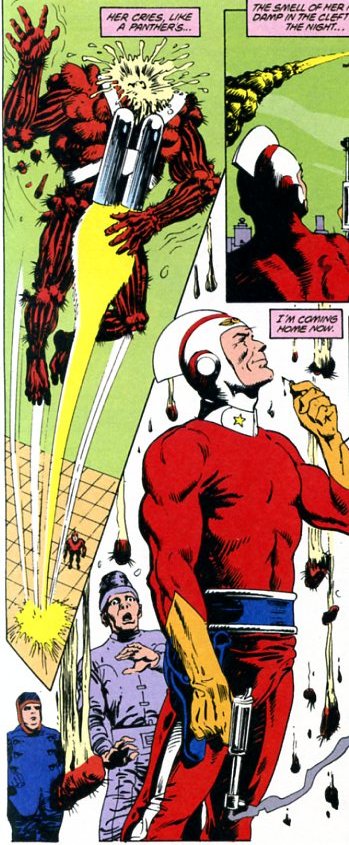
“Her cries like a panther’s” indeed.
Of course, that same page we’ve got Adam with that ridiculous headgear holding his smoking gun at crotch level. After that, it’s almost (ahem) anti-climactic when Swampy uses his powers to refertilize Rann…or when we learn that Adam has been brought to Rann because the “fierce vitality” of his sperm is needed to impregnate Alanna on a world where all the men are apparently sterile.
The person talking all up in Adam’s fierce virility is not his wife, but rather Keela Roo, a Thanagarian hawk warrior. Keela Roo is a very different kind of feminine. Instead of waiting at home in a castle, she sallies forth in spikes and skin and fetish boots. She wears a big flamboyant headress that stands in stark contrast to her male-subordinates unadorned helmet. She is, in short, a dominatrix and a castrating bitch; vital, animal, sexy, and unhealthily virile. Here, for example, she goes after Swampy by inserting her big phallic weapon into his split and oozing orifice.
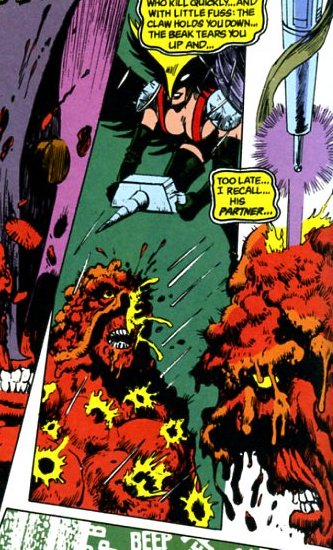
As is generally the case in these pulp narratives, the dark queen is scary, but she’s also attractive — not least because she actually has a personality. Abby doesn’t exist (in these issues) except as a name and a desire. Alanna never speaks in English, and though her Rannian dialect isn’t entirely opaque,and though we do get to see her desire for Adam, keeping her voice from the reader effectively makes her seem distant, exotic, mysterious, soft-spoken, and unattainable. The princess in the tower again.
Keela Roo, on the other hand, has a universal translator thingee — she wants you to know what she thinks. Language is something she has mastered, and she uses it seductively. Several scenes between her and Adam have a not-very-subliminal sexual subtext. Here she is wearing that preposterous outfit while Adam talks to her in his bathrobe:
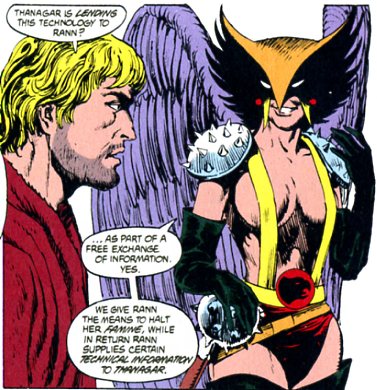
And this next sequence is a brazen come on (with Adam in a bathrobe again. Doesn’t he ever get dressed?)
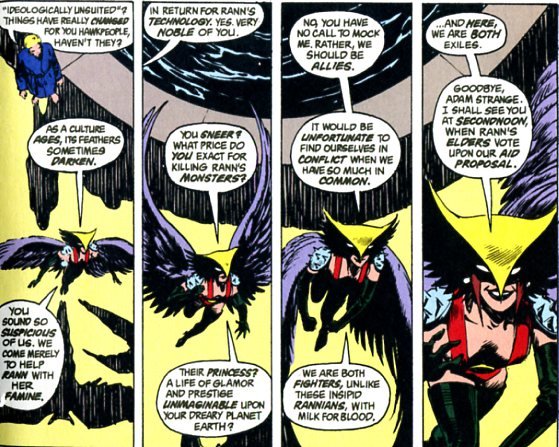
That “aid proposal” seems very like a euphemism for another kind of proposal, especially as we’re getting a shot down her cleavage.
Keela Roo tells Adam, “We are both fighters,” and she’s right of course. The problem is that she’s the wrong kind of fighter. She’s a twisted fighter, a perverted fighter — in short, a cross-dressing, feminine kind of fighter, when the right kind of fighter is a male fighter.
Thus, poetic justice demands that Keela Roo be killed, not in equal combat, but by domesticity itself. In battle, she manages to kick Adam Strange’s ass, but he fools her by leading her to his home, where his household guardian water creatures disposes of her. She is, then, not merely defeated, but humiliated — her fetish mask is torn from her, stripping her faux masculinity and leaving her as just a woman after all.

In the final twist of the knife, the creature who disposes of her is itself feminine (taking the form of a cat); a liquid female personification of hearth and home, which makes short work of that other woman Adam has been dallying with so that he and Alanna can be reunited again.
The point here isn’t that Moore is an irredeemable sexist, or even that this story’s handling of gender is particularly offensive. Rather, the point is that Moore, here and elsewhere, is using tried and true genre ideas (male quests; adventure vs. home.) And his main means for dealing with those concerns are received pulp tropes or DC comics ideas. Alanna is a princess not because Alan Moore made her one, but because some old DC writer steeped in Edgar Rice Burroughs and Flash Gordon made her one; the hawk woman is dressed like that because some pulp dc writer steeped in pulp cheesecake figured why the hell not.
Moore takes these ideas and runs with them…but though he runs pretty far, he doesn’t necessarily run to a different planet. In space opera, good women are beautiful paragons who sit at home being good and nurturing; bad women are aggressive and dominant and get killed off despite (or because of) their appeal. And that’s the way it is in Moore’s space opera as well.
Eric argues that at the end of the series, Moore undermines standard pulp narratives about revenge, domestic bliss and male power. But to me at least, reading back through some of these stories, Moore’s use of pulp in Swamp Thing seems less like undermining and more like assiduously and inventively cultivating.
__________________
You can read the whole Swamp Thing roundtable here.
Jog’s massive concluding Swamp Thing blowout post will be up tomorrow.

